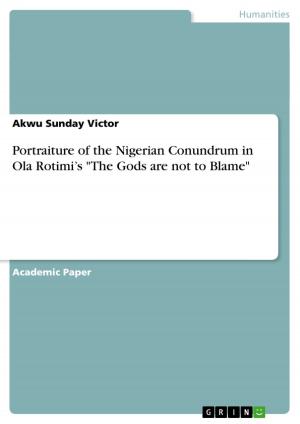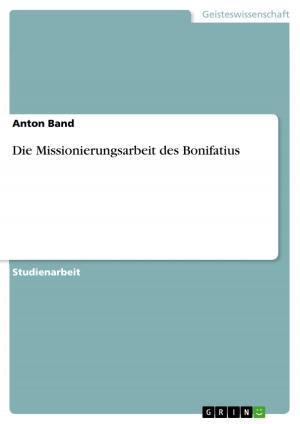Marriage in the 'Marriage Group Tales' of The Canterbury Tales
Nonfiction, Entertainment, Drama, Anthologies| Author: | Simone Petry | ISBN: | 9783638537766 |
| Publisher: | GRIN Verlag | Publication: | August 24, 2006 |
| Imprint: | GRIN Verlag | Language: | English |
| Author: | Simone Petry |
| ISBN: | 9783638537766 |
| Publisher: | GRIN Verlag |
| Publication: | August 24, 2006 |
| Imprint: | GRIN Verlag |
| Language: | English |
Seminar paper from the year 2004 in the subject English Language and Literature Studies - Linguistics, grade: 2,7, University of Trier, course: Englische Sprachwissenschaft, 22 entries in the bibliography, language: English, abstract: The Canterbury Tales are a collection of twenty-three tales written by Geoffrey Chaucer in the fourteenth century. A frame tale embraces the different tales which are told by a group of pilgrims on their way from Southwark to Canterbury where the group wants to visit the sacred shrine of Saint Thomas Becket. In order to make their pilgrimage more enjoyable, the pilgrims decide that each pilgrim tells two stories on their way to Canterbury and two on the return trip. The Host will then decide which was the best tale. However, The Canterbury Tales are incomplete. With all of the thirty pilgrims telling four stories, there should have been a hundred and twenty tales in all according to the original plan. But Chaucer only completed twenty-three tales. In the Middle Ages, pilgrimage was a social as well as a religious event. Different social classes were mingled together. All the three strata of fourteenth century English society are represented in the tales - the nobility, the clergy and the commoners. The themes in The Canterbury Tales are as various as the pilgrims are. Some tales deal with the corruption of the Church and religious malpractice. Therefore, a number of churchmen and churchwomen are depicted and often treated ironically. Another important theme in the tales is the corruptness of human nature which can be linked to the theme of the decline of moral values. Chivalry is depicted in some tales, often closely connected to the concept of courtly love. The position of women in the Middle Ages as well as their position in marriage relationships are themes which appear in some way or the other in almost all of the tales. Four of the tales have even been called the 'Marriage Group'. The following paper is going to deal with marriage in the 'Marriage Group Tales' of The Canterbury Tales. The first part of this paper will examine the importance of marriage in the Middle Ages and the position of women in medieval society. Then, the development of the idea of courtly love will be presented. In a second part, this paper is going to give a short survey about all the tales dealing with marriage. The idea of a 'Marriage Group' in The Canterbury Tales will then be presented. The last section of this paper will deal with two of the tales which constitute the beginning and the end of the 'Marriage Group', namely the Wife of Bath's Tale and the Franklin's Tale.
Seminar paper from the year 2004 in the subject English Language and Literature Studies - Linguistics, grade: 2,7, University of Trier, course: Englische Sprachwissenschaft, 22 entries in the bibliography, language: English, abstract: The Canterbury Tales are a collection of twenty-three tales written by Geoffrey Chaucer in the fourteenth century. A frame tale embraces the different tales which are told by a group of pilgrims on their way from Southwark to Canterbury where the group wants to visit the sacred shrine of Saint Thomas Becket. In order to make their pilgrimage more enjoyable, the pilgrims decide that each pilgrim tells two stories on their way to Canterbury and two on the return trip. The Host will then decide which was the best tale. However, The Canterbury Tales are incomplete. With all of the thirty pilgrims telling four stories, there should have been a hundred and twenty tales in all according to the original plan. But Chaucer only completed twenty-three tales. In the Middle Ages, pilgrimage was a social as well as a religious event. Different social classes were mingled together. All the three strata of fourteenth century English society are represented in the tales - the nobility, the clergy and the commoners. The themes in The Canterbury Tales are as various as the pilgrims are. Some tales deal with the corruption of the Church and religious malpractice. Therefore, a number of churchmen and churchwomen are depicted and often treated ironically. Another important theme in the tales is the corruptness of human nature which can be linked to the theme of the decline of moral values. Chivalry is depicted in some tales, often closely connected to the concept of courtly love. The position of women in the Middle Ages as well as their position in marriage relationships are themes which appear in some way or the other in almost all of the tales. Four of the tales have even been called the 'Marriage Group'. The following paper is going to deal with marriage in the 'Marriage Group Tales' of The Canterbury Tales. The first part of this paper will examine the importance of marriage in the Middle Ages and the position of women in medieval society. Then, the development of the idea of courtly love will be presented. In a second part, this paper is going to give a short survey about all the tales dealing with marriage. The idea of a 'Marriage Group' in The Canterbury Tales will then be presented. The last section of this paper will deal with two of the tales which constitute the beginning and the end of the 'Marriage Group', namely the Wife of Bath's Tale and the Franklin's Tale.















